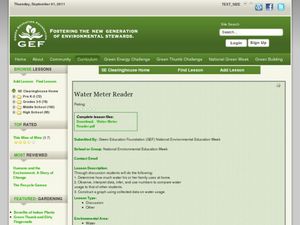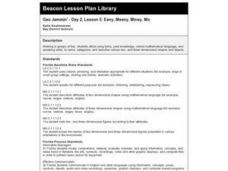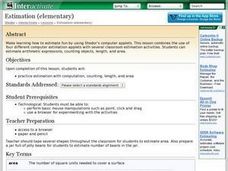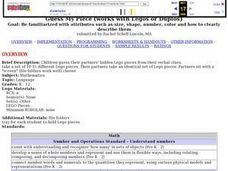Curated OER
Angles Lesson Plan
Students stud angles, and then play the "What's Your Angle?" game. They complete at least 10 computer generated problems from the Angles Applet.
Curated OER
Area Lesson Plan
Young scholars manipulate a variety of materials and computer applets in order to explore area and the units used to measure it.
Curated OER
Water Meter Reader
Students examine a water bill from their household and examine it to find out how much water is used each month. They read their home water meters at the same time of the day for seven days and then construct a graph using their data.
Curated OER
Average Looking
Students use measurements of their classmates to find the average (means and modes) of their facial features. They use their findings to create a three-dimensional "class head." Examples and assessment materials are included.
Curated OER
Pea Brain! Explorations in Estimation
Young scholars estimate how many peas fit in a container. In this science lesson, students calculate the weight of a pea and record it. They use this data to calculate how many peas fit in a human brain.
Curated OER
What Does Greatest Common Factor Mean to Me?
Students see a demonstration of the concept of factors through modeling. They do an activity that help them explain further the concept of common factors and greatest common factor.
Curated OER
Geo Jammin' - Day 2, Lesson 5: Eeny, Meeny, Miney, Mo
Students, in groups, use song lyrics and math to descrie two and three dimensional shapes.
Curated OER
Geo Jammin' - Day 6, Lesson 20: Hail, Hail, the Gang's All Here
Young scholars use shape puppets to review geometry content. They take turns singing songs, reading students poems, reciting class bulletin board notes and choral poems. They prepare for their summative assessments through play and...
Curated OER
Water Density Boundaries
Young scholars create observable layers in water that represent a separation based upon density differences. They model density boundaries using differences in temperature and salinity. They, in groups, perform a meaningful experiment...
Curated OER
Estimation Lesson Plan
Students use four different computer estimation applets with several classroom estimation activities.
Curated OER
Triangle Explorer
Students calculate the area of triangles using a variety of materials including computer applets.
Curated OER
How Much is a Million?
Fifth graders explore relationship among customary and/or metric units of measurement.
Curated OER
Black Bayou Lake Measures Up
Pupils, in groups, estimate measurments and then select the tools needed and measure various items at Black Bayou Lake refuge.
Curated OER
Guess My Piece -working with Legos
Students participate in guessing their partners' hidden Lego pieces from their verbal clues. They work in partners to accomplish their goals. They are meeting a variety of math standards by completing this lesson.
Curated OER
Fences and Posts
Fifth graders use Geoboards to demonstrate how shapes can be made by looping the rubber bands over the nails. They make a triangle on their Geoboards. At least one side of the triangle should be either horizontal or vertical. The picture...
Curated OER
Worms and more
Students have early length experiences must develop an awareness of what length is, and of the range of words that can be used to discuss length. Young children usually begin by describing the size of objects as big and small. They...
Curated OER
How far is a km?
Students explore the size of a kilometer and the time it takes to cover this distance. They develop a concept of a km. They measure a distance of 1 km and the time taken to cover it.
Curated OER
A Fashion Extravaganza
Students decide what body measurements they need to make garments such as a pair of pants. They make a list, and work with a partner to take and record those measurements in centimeters. They discuss the use of centimeters.
Curated OER
Weights
Young scholars find an object that they estimate weighs 20g and check estimates on the balance scales. They read the problem and work in pairs focusing their understanding on the size of grams.
Curated OER
Measurement
Young scholars use arithmetic in a practical situation using time and distance.
As the calculations involved in this problem involve single digit addition and multiplication it offers a good opportunity to encourage the students's use...
Curated OER
Peter's String
Students are introduced to the math problem and consider how they could approach it. In pairs, students investigate Peter's conjecture in any way they see fit. They then share their answers with the class.
Curated OER
THE TRAVELS OF BABAR: An Adventure in Scale :Building a Model Hot Air Balloon
Students encounter basic facts about helium and hot air. They compare the weight and size of different materials. Students work collaboratively in teams. They create their own model balloon.
Curated OER
Base 10 Rounding
Students build two, three, and four digit numbers using base ten blocks and round those numbers. In this rounding numbers lesson, students work in pairs and build numbers using base ten blocks.
Curated OER
Build A Better Candy Bag
Students design a candy bag in order to create one that can hold the greatest weight without breaking. They create a model after the design is put down on paper. The bag is then tested with different weights and redesigned as necessary.
Other popular searches
- Volumes of Solids
- Geometry Nets Volumes
- Volumes of Revolution
- Volumes of Prisms
- Calculus Volumes
- Measuring Volumes
- Volumes and Surface Areas
- Volumes of Cylinder and Prisms
- Volumes of Spheres
- Measuring Volumes Beakers
- Activities on Volumes
- Measuring Volumes of Liquide

























